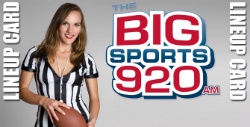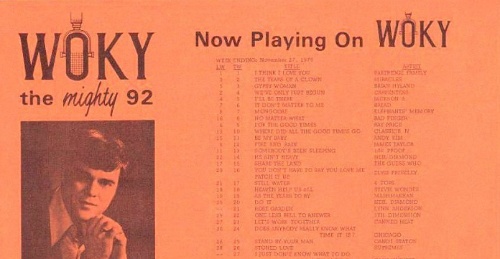Nielsen Audio ratings for Milwaukee came out a couple of weeks ago, and the legendary WOKY (a/k/a “Fun-Lovin’ WOKY,” a/k/a “The Mighty 92”) was bringing up the rear with a .1 share.
As I’ve written in this space before, one of my first jobs in radio was, back in my high school days, answering the WOKY request lines for a summer. This “.1 share” finding just couldn’t be right, I felt.
Nonetheless, let’s do the math: I believe the Milwaukee metro has about 1.4 million people in it. We know from Nielsen Audio that the average American in 2014 listens to radio for a bit under 12 hours a week, which is about 1/10 of the time (assuming a 6a-12m broadcast week, which is 126 hours), so for easy math let’s say about 140,000 Milwaukeeans are listening to the radio at any given moment.
A station with a 1.0 share would thus have 1% of those people listening at the average moment, or about 1,400 people. And a station with a .1 share, like supposedly WOKY, would have a tenth of that, or about 140 people.
For land’s sake, there are bratwurst restaurants in Milwaukee that sometimes have more than 140 people in them!
Wow.
 Nowadays WOKY is a Clear Channel-owned sports-talk station nicknamed “The Big 920.” We used to believe WOKY had a great signal. Clear Channel has lots of resources and a good market manager. Milwaukeeans like sports.
Nowadays WOKY is a Clear Channel-owned sports-talk station nicknamed “The Big 920.” We used to believe WOKY had a great signal. Clear Channel has lots of resources and a good market manager. Milwaukeeans like sports.
So what’s up?
- Wisconsonites are very geo-partisan in their sports tastes: They care very much about the Brewers, Packers, Bucks, and Badgers (and maybe Admirals), and they vehemently don’t care about teams based in Chicago, Minneapolis, or elsewhere. So any sports-talk station running a national feed from ESPN or CBS Sports or wherever might have, compared to other markets, relatively limited appeal (unless it happens to be pro-Brewers, pro-Packers, pro-Bucks, or pro-Badgers at the moment).
- Although the ratings say there’s only one sports radio competitor in town (Entercom’s .5-share “Sports Radio 1250,”), there is a second one (Craig Karmazin’s “549 ESPN”) that I believe is not a Nielsen Audio subscriber. More importantly, though, the truth is that Journal Broadcasting’s flagship, 7-share WTMJ is a news-talk that historically has had a very heavy sports component, including a history of carrying almost all the major play-by-play broadcasts that spans more than a half-century (plus of course all the associated pre-game, halftime, and post-game shows).
- To adults in the 50+ demo, the brand names “WOKY” and “WRIT” mean ’60s hits, with WOKY usually the leader and WRIT traditionally the weak #2. WRIT’s call letters are attached nowadays to a successful Clear Channel-owned FM oldies station; WOKY’s aren’t. There may be a disconnect in older consumers’ minds between the brand name’s meaning and the product it’s attached to. (Analogy: 50/50 would be a bad brand name for a cola, since its heritage is that it was a grapefruit soda.) (Although I’m sure the use of such famous call letters is helpful to Clear Channel AEs on the ad sales side.)
- I’m not sure whether this is a problem or a opportunity, but I believe Nielsen Audio has around 1,000 PPM meters in the Milwaukee market. Given the market’s population size, as noted above, that means that each meter represents about 1,400 people. So to end up with an AQH of 140, WOKY must have had the equivalent of one PPM listening to it about 1/10th of the time, or about 1.8 hours per day (6a-12m). So, the opportunity is that if just one PPM panelist becomes a true WOKY fan and starts listening 2 to 8 hours per day, its ratings could instantly double or triple or quadruple or even quintuple.
- Could Clear Channel make “live and local” work in this situation? There are lots of former radio air personalities living in the region (e.g., Big Tomm Rivers), many of whom I imagine could manage to credibly talk about sports. If WOKY really has an AQH of 140, assuming advertisers would pay a $10 CPM for the attractive demo (as sports-talk stations usually have great qualitative), that implies a unit rate of $1.40 (i.e., slightly better than a dollar a holler). Run 15 spots an hour, let’s say 15 hours a day, 365 days a year, that’s about $115K a year in gross revenues. If you ran WOKY, could you hire two or three live personalities at $40K to $60K each (although you might also need to hire producers/screeners and a PD) and get your share up at least another .1?
This whole situation of WOKY being a .1 share station still raises a whole bunch of questions: (A) What can you do with an underperforming AM signal nowadays? (B) What’s the best use of heritage call letters? (C) In interpreting and analyzing ratings, isn’t it insightful to calculate how many active PPMs a rating might represent? (D) Is “live and local” a viable option in a situation like this?
Would welcome your thoughts in the comments section below.


(A) What can you do with an underperforming AM signal nowadays?
Tap into an older demographic by establishing a rapport with a senior community and do live radio with guests who reside at the facilty
(B) What’s the best use of heritage call letters?
As a heritage reminder
(C) In interpreting and analyzing ratings, isn’t it insightful to calculate how many active PPMs a rating might represent?
Yes
(D) Is “live and local” a viable option in a situation like this?
It sure is